Related Research Articles
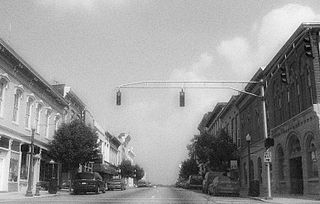
Shelbyville is a home rule-class city in and the county seat of Shelby County, Kentucky, United States. The population was 14,045 at the 2010 census.

The Kentucky River is a tributary of the Ohio River, 260 miles (418 km) long, in the U.S. Commonwealth of Kentucky. The river and its tributaries drain much of the central region of the state, with its upper course passing through the coal-mining regions of the Cumberland Mountains, and its lower course passing through the Bluegrass region in the north central part of the state. Its watershed encompasses about 7,000 square miles (18,000 km2). It supplies drinking water to about one-sixth of the population of the Commonwealth of Kentucky.

The geology of the Ohio River, with a but a single series of rapids halfway in its length from the confluence of the Monongahela and Allegheny rivers to its union with the Mississippi, made it inevitable that a town would grow on the site. Louisville, Kentucky was chartered in the late 18th century. From its early days on the frontier, it quickly grew to be a major trading and distribution center in the mid 19th century, important industrial city in the early 20th, declined in the mid 20th century, before revitalizing in the late 20th century as a culturally-focused mid-sized American city.
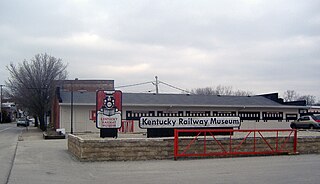
The Kentucky Railway Museum, now located in New Haven, Kentucky, United States, is a non-profit railroad museum dedicated to educating the public regarding the history and heritage of Kentucky's railroads and the people who built them. Originally created in 1954 in Louisville, Kentucky, the museum is at its third location, in extreme southern Nelson County. It is one of the oldest railroad stations in the United States.
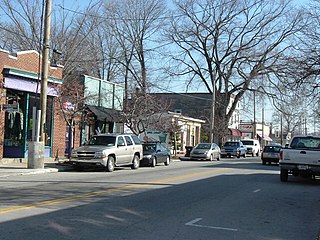
Clifton is a neighborhood east of downtown Louisville, Kentucky USA. Clifton was named because of its hilly location on the Ohio River valley escarpment. Clifton is bounded by I-64, N Ewing Ave, Brownsboro Road, and Mellwood Ave.

Crescent Hill is a neighborhood four miles (6 km) east of downtown Louisville, Kentucky USA. This area was originally called "Beargrass" because it sits on a ridge between two forks of Beargrass Creek. The boundaries of Crescent Hill are N Ewing Ave to the St. Matthews city limit by Brownsboro Road to Lexington Road. Frankfort Avenue generally bisects the neighborhood.

John LaRue Helm was the 18th and 24th governor of the U.S. Commonwealth of Kentucky, although his service in that office totaled less than fourteen months. He also represented Hardin County in both houses of the Kentucky General Assembly and was chosen to be the Speaker of the Kentucky House of Representatives four times. In 1838 his sole bid for federal office ended in defeat when his opponent, Willis Green, was elected to the U.S. House of Representatives.
The Point was a thriving 19th century neighborhood in Louisville, Kentucky, east of Downtown Louisville and opposite Towhead Island along the Ohio River. It was also located north of the present day Butchertown area.
Harlan Hubbard was an American artist and author, known for his simple lifestyle.

Kentucky was a border state of key importance in the American Civil War. It officially declared its neutrality at the beginning of the war, but after a failed attempt by Confederate General Leonidas Polk to take the state of Kentucky for the Confederacy, the legislature petitioned the Union Army for assistance. After early 1862 Kentucky came largely under Union control.

Louisville in the American Civil War was a major stronghold of Union forces, which kept Kentucky firmly in the Union. It was the center of planning, supplies, recruiting and transportation for numerous campaigns, especially in the Western Theater. By the end of the war, Louisville had not been attacked once, although skirmishes and battles, including the battles of Perryville and Corydon, took place nearby.

William Justus Goebel was an American politician who served as the 34th Governor of Kentucky for four days in 1900 after having been mortally wounded by an assassin the day before he was sworn in. Goebel remains the only state governor in the United States to be assassinated while in office.
Interstate 64 (I-64) in the U.S. state of Kentucky travels for 191 miles (307 km), passing by the major towns and cities of Louisville, Frankfort, Lexington and Ashland. It has several major junctions with other Interstates, including I-65, I-71, I-264 and I-265 in Louisville, and I-75 in Lexington.
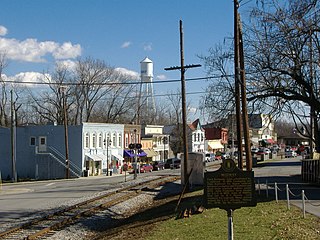
The Midway Historic District of Midway, Kentucky, was designated by the National Register of Historic Places as a historic district on November 17, 1978. In 2003, faced with a declining downtown, a major streetscape renovation project began as part of the Kentucky Main Street Program.
The Louisville and Frankfort Railroad (L&F) was a 19th-century railroad in the U.S. state of Kentucky.
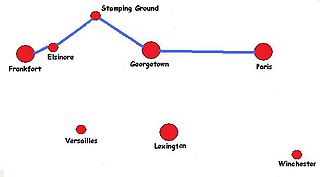
The Frankfort and Cincinnati Railroad is a defunct shortline railroad based in Kentucky. Despite its name, it had no connections with Cincinnati, Ohio.
The following is a timeline of the history of Lexington, Kentucky, United States.
The Louisville, Cincinnati and Lexington Railroad was a 19th-century railway company in the U.S. state of Kentucky. It operated from 1869, when it was created from the merger of the Louisville and Frankfort and Lexington and Frankfort railroads, until 1877, when it failed and was reincorporated as the Louisville, Cincinnati and Lexington Railway. It later made up part of the Louisville and Nashville network and its former rights-of-way currently form parts of the class-I CSX Transportation system.
John Jeremiah Jacob was an American businessman, financier, real estate developer, and philanthropist active in Kentucky. He was involved in banking, as well as in commerce, real estate and infrastructure: railroads, canal, bridge, and utilities.
References
| This article about transportation in Kentucky is a stub. You can help Wikipedia by expanding it. |
| This United States rail–related article is a stub. You can help Wikipedia by expanding it. |
| This Louisville-related article is a stub. You can help Wikipedia by expanding it. |